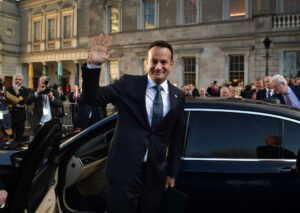“The transformation of Ireland over the last 60 years has sometimes felt as if a new world had landed from outer space on top of an old one,” wrote Fintan O’Toole, a commentator who is generally approving of this new status quo, in 2021. But the past weeks and months have proven that the “old” country has very different ideas about this extra-terrestrial political order. After Ireland rejected two liberal amendments to the constitution, tabled and sponsored by their government, civic disturbances on a scale not seen for generations continue. They even wear the aesthetic of an older Ireland, with youths on horseback leading a recent protest against a new asylum centre in Dublin.
Though the referendums in question were largely symbolic and had little substantial effect on everyday life, scepticism of immigration is now widespread. Recent polling suggests that three-quarters of Irish people think the country is taking too many refugees, a statistic that rises to 80% among Sinn Féin supporters. The modern, secular and multicultural face that Ireland’s government showed to the world for decades has been revealed as a mere patina. And yet, this should not be considered just a spasm from within an otherwise innately progressive Irish character. In many ways, this is the kind of Irishness historically seen abroad; the Irish-American diaspora diverged well to the Right of its mother country long ago — and those values are now travelling back across the Atlantic.
In 1841, 60,000 Irish people signed a petition calling for their compatriots in America to throw their support behind the anti-slavery abolition movement. The petition was organised by Daniel “the Liberator” O’Connell, whose opposition was long-held and steadfast. When O’Connell was first elected to parliament 11 years earlier, a member with an interest in the Caribbean sugar plantations had approached him and offered the support of the 27 pro-slavery members on Irish issues in exchange for his neutrality on the question. O’Connell responded that though “God knows I speak for the saddest people the sun sees”, he was not willing to “forget the negro one single hour” in order to save Ireland. In his public speeches O’Connell attacked American hypocrisy on this issue: “America in the fullness of her pride… wave[s] on high her banner of freedom and its blazing stars” while ignoring “the negro children screaming for their mother from whose bosom they have been torn”.
O’Connell pledged that he would never visit America while slavery continued in that country, and US abolitionists encouraged him to do more to persuade the Irish in America to adopt his stance. One argued that if O’Connell were able to change these opinions, it could be decisive, as “your countrymen among us hold the balance of power”, yet as it stood “three fourths of them at least are Democrats” and opposed slavery abolition. But the Irish in America did not respond as O’Connell hoped. Not only did the majority support the continuation of slavery, but in many cases they were the perpetrators of some of the worst incidences of mob violence against African Americans, such as when an Irish crowd attacked a black temperance parade in Philadelphia in August 1842. And in 1854, it was Irish militia companies who were called on to return runaway slave Anthony Burns from Boston to Virginia, after the native-born companies refused to do so.
Bishop John Hughes of New York, at that time probably the most influential Irish American leader, said it was “the duty of every naturalized Irishman to resist and repudiate” O’Connell’s implorations “with indignation”. And this vehemence was partially defensive, a product of Hughes’s concern with the successful integration of the Irish into the broader American population — no easy task given the hostility they faced. Leading Irish figures feared that any question of divided loyalties would fatally undermine this process. But another motive was that abolitionism was associated with the British, who had ended their trade in 1807 and emancipated the slaves in their colonies in 1834.
Given the intense opposition to anything associated with Britain, many Irish were opposed to abolition on those grounds alone. It also didn’t help that many abolitionists, drawn as they often were from New England Nonconformist backgrounds, hated Catholics intensely. But, as the historian Noel Ignatiev argued, Irish-American support for the continuation of slavery was necessary as it “eased their assimilation as whites, and more than any other institution, taught them the meaning of whiteness”. For Ignatiev, the Irish were deeply concerned with maintaining their favoured position over those whom they regarded as the principal threat — the free black people of the North — and abolition would have magnified that threat.
This compact between Irish Americans and the Democratic Party, formed in the antebellum United States over slavery, began to erode a few decades ago, through a combination of the former’s increasing affluence and the Democrats’ shift Leftwards on cultural issues. Irish Americans on average have remained firmly on the Right, and are now a key constituency for Donald Trump. And although a liberal evolution over the generations is standard for immigrant groups, the Catholic Church’s conservative position on many issues, particularly on abortion, had the effect of making Irish Americans particularly conservative.
But in Ireland itself, the opposite process took place, transforming the country from one of the most conservative in Europe, to one of the most progressive, within a single generation. As recently as 1983, Irish voters approved the Eighth Amendment to the constitution, outlawing abortion with 67% support. Just over three decades later, in 2015, 62% of Irish voters approved the legalisation of same-sex marriage, and three years later 66% voted to legalise abortion. This led to the strange situation observed by one bartender working in a New York Irish pub during the 2016 presidential election, whereby “half the patrons were Irish immigrants who considered Mr. Trump a real ‘eejit,’ but the other half, the Irish Americans, thought he was just grand”.
The events of recent months, however, suggest this dichotomy is changing. So far, there has been a void of support for such positions within the mainstream political parties, all of which supported the proposed constitutional changes, and all which have been vocally supportive of increased immigration for years. But politicians might be waking up to the changing reality: despite leading the same party as his predecessor, Leo Varadkar, the new prime minister, Simon Harris, has emphasised supporting farmers and preserving “law and order”. Perhaps he has a better grasp of the situation. But the present unrest is a product of longstanding issues, with rampant inequality, an acute housing crisis and rapid increases in immigration levels all playing their part. The conditions which created the Irish diaspora identity abroad are coming home.
The Irish in America developed this identity through the imperative of protecting their status — against challenges from above by Protestant, Anglo-Saxon Americans, and from below by black people (and then, more recently, by Latino immigrants). For the Irish in Ireland, their historic national identity developed primarily in opposition to Britishness, while in contemporary Ireland this has been considerably defined through opposition to the Catholic Church. One of the main reasons for the health of organised religion in the United States (until the last decade or so anyway), was the lack of an official state Church: with no suppression of dissenting faiths, and with free and healthy competition, American Christians of all stripes maintained religious enthusiasm long after it waned elsewhere. In contrast, while the Republic of Ireland never had an official state religion, its constitution and laws were intimately linked with Catholicism. And given the many wrongdoings of the Church — from the Magdalene laundries and sexual abuse to plain old-fashioned corruption — there was a ready-made enemy for people to fight against.
Today, a nationalist sentiment that was once anti-British has a new focus of antagonism now that Ireland has become, for the first time in its history, a net importer of people. Meanwhile, the conformism and repression than was once enforced by the Catholic Church has been replaced by a new type of conformism enforced by politicians, journalists, academia and NGOs. Ignatiev explained the divergence on slavery between the Irish in Ireland and the Irish in American by arguing that “in becoming white, the Irish ceased to be green”. Today, cosmopolitan Ireland itself has ceased to be “green” — in the stereotypical sense of smoky pubs, pints of Guiness and pederast priests. Instead, its urban centres have embraced the global digital monoculture, which can now be found in Tipperary as much as Toronto and Tel Aviv. The experience of the Irish overseas — economic competition and status anxiety, generating a defensive, oppositional politics — now applies to the Irish in Ireland.
There is not only heightened competition for housing and state services, but also for social prestige. Until recently, Irish culture had common enemies, but now working-class and non-graduate Irish people find they are facing a reduction in their cultural and social status. When the enemy were landlords and the British, it was easy enough to create a shared identity in opposition to those forces. Then, after the great estates were broken up and the British left, that vanished. Ireland’s subsequent transition from one of the most conservative countries in Europe to one of the most liberal could be shaped by collective opposition to the Catholic Church — but now too that opposition is gone, its enemy vanquished.
If the conditions that have traditionally faced the Irish in America are replicated in Ireland itself, then the politics of the Irish diaspora might be a good guide as to what happens next. The split between traditional Republicans and the Trump MAGA movement might be replicated by a split within one of the main Irish parties — and not necessarily one of the traditional Right. The ascent of Sinn Féin, for example, may be halted due to tensions between the social conservatism of much of their voters and their activist vanguard’s liberal internationalism. It is unlikely that the former sentiments will continue to be unrepresented in the Dáil: either new leadership in one of the established parties will follow the voters and shift to the Right on culture, or potentially a new party will emerge, helped by the proportional system used for Irish parliamentary elections. Either way, the next few years will be tumultuous. The global populist insurgency that has changed politics in so many of Ireland’s neighbours has finally arrived.
Disclaimer
Some of the posts we share are controversial and we do not necessarily agree with them in the whole extend. Sometimes we agree with the content or part of it but we do not agree with the narration or language. Nevertheless we find them somehow interesting, valuable and/or informative or we share them, because we strongly believe in freedom of speech, free press and journalism. We strongly encourage you to have a critical approach to all the content, do your own research and analysis to build your own opinion.
We would be glad to have your feedback.
Source: UnHerd Read the original article here: https://unherd.com/



